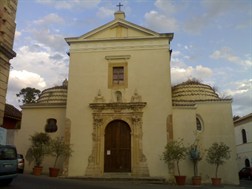Crotone
 During the Baroque period and in general during the period of the Spanish viceroyalty (1503-1707), Calabria underwent one of the most difficult periods of its history. The region was devastated by a long series of natural calamities: after the earthquake of 1638, which caused over 10.000 deaths, other tragic seismic events were registered in 1659 and above all in 1783, when a large part of Calabria’s artistic heritage was destroyed. These events, along with frequent famines (such as that of 1672), and epidemics (the plague of 1656-1657 which affected all of the Kingdom of Naples) and an adverse climatic situation (the so-called little ice age) contribute to explaining the negative demographic development of the region, characterized, with the exception of the first part of the sixteenth century, by a low birth rate along with a high mortality rate. Another factor of weakness and a constant danger for the inhabitants of Calabria in the early modern period were the frequent incursions of Turkish and Barbary pirates on the coasts. In spite of the defensive measures and the line of towers and guards along the coast, the pirates attacked Calabria constantly, reaching inland and sacking whole cities. Often the advice of Calabrian renegades, men who had been taken into captivity by pirates and then converted to Islam, moved by a sort of desire for revenge against their native land and its inhabitants, was decisive for these incursions which were led by men such as Khair-ed-din, Barbarossa, Dragut Rayz il Cicala or Uluc-Alì (also known as Occhialì)
During the Baroque period and in general during the period of the Spanish viceroyalty (1503-1707), Calabria underwent one of the most difficult periods of its history. The region was devastated by a long series of natural calamities: after the earthquake of 1638, which caused over 10.000 deaths, other tragic seismic events were registered in 1659 and above all in 1783, when a large part of Calabria’s artistic heritage was destroyed. These events, along with frequent famines (such as that of 1672), and epidemics (the plague of 1656-1657 which affected all of the Kingdom of Naples) and an adverse climatic situation (the so-called little ice age) contribute to explaining the negative demographic development of the region, characterized, with the exception of the first part of the sixteenth century, by a low birth rate along with a high mortality rate. Another factor of weakness and a constant danger for the inhabitants of Calabria in the early modern period were the frequent incursions of Turkish and Barbary pirates on the coasts. In spite of the defensive measures and the line of towers and guards along the coast, the pirates attacked Calabria constantly, reaching inland and sacking whole cities. Often the advice of Calabrian renegades, men who had been taken into captivity by pirates and then converted to Islam, moved by a sort of desire for revenge against their native land and its inhabitants, was decisive for these incursions which were led by men such as Khair-ed-din, Barbarossa, Dragut Rayz il Cicala or Uluc-Alì (also known as Occhialì)
The Calabrian cities share this common and difficult past, often maintaining evident traces of it. One significant example is that of Crotone, a fortified city and fundamental bastion in the defence against Barbary pirates. The construction works of its defensive system began under the reign of Charles V and were only completed in 1647. Inside the city itself Crotone (which, in the early modern period was called Cotrone) conserves few examples of Baroque art. An exception is that of the Church of San Giuseppe (photo), constructed in the first half of the eighteenth century and consecrated in 1756.
